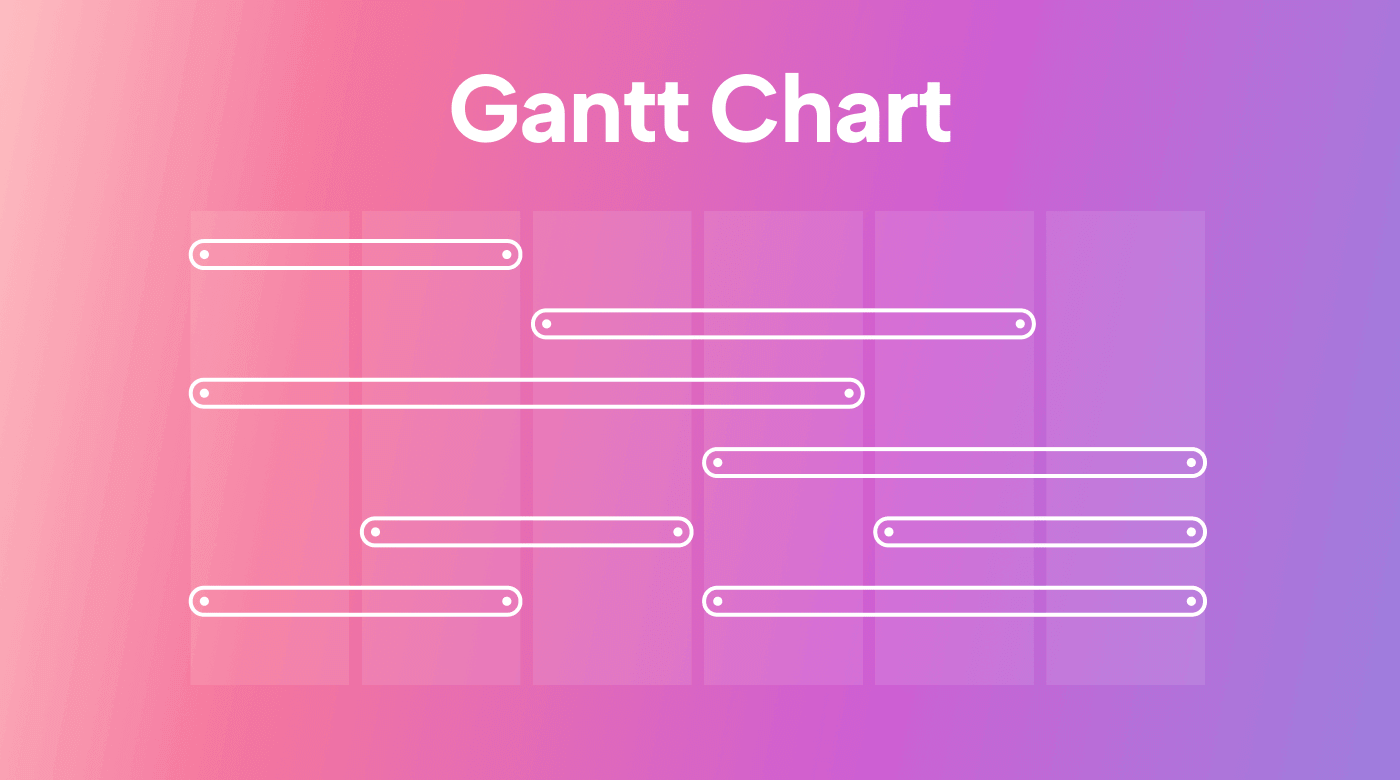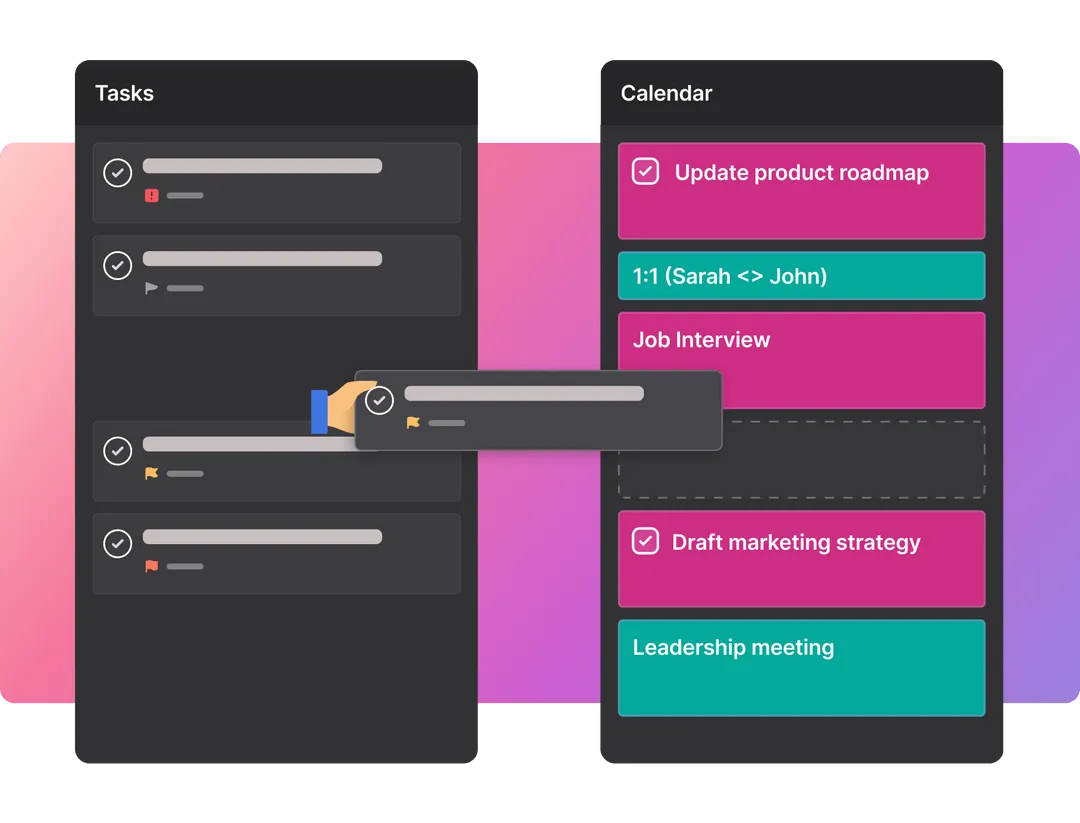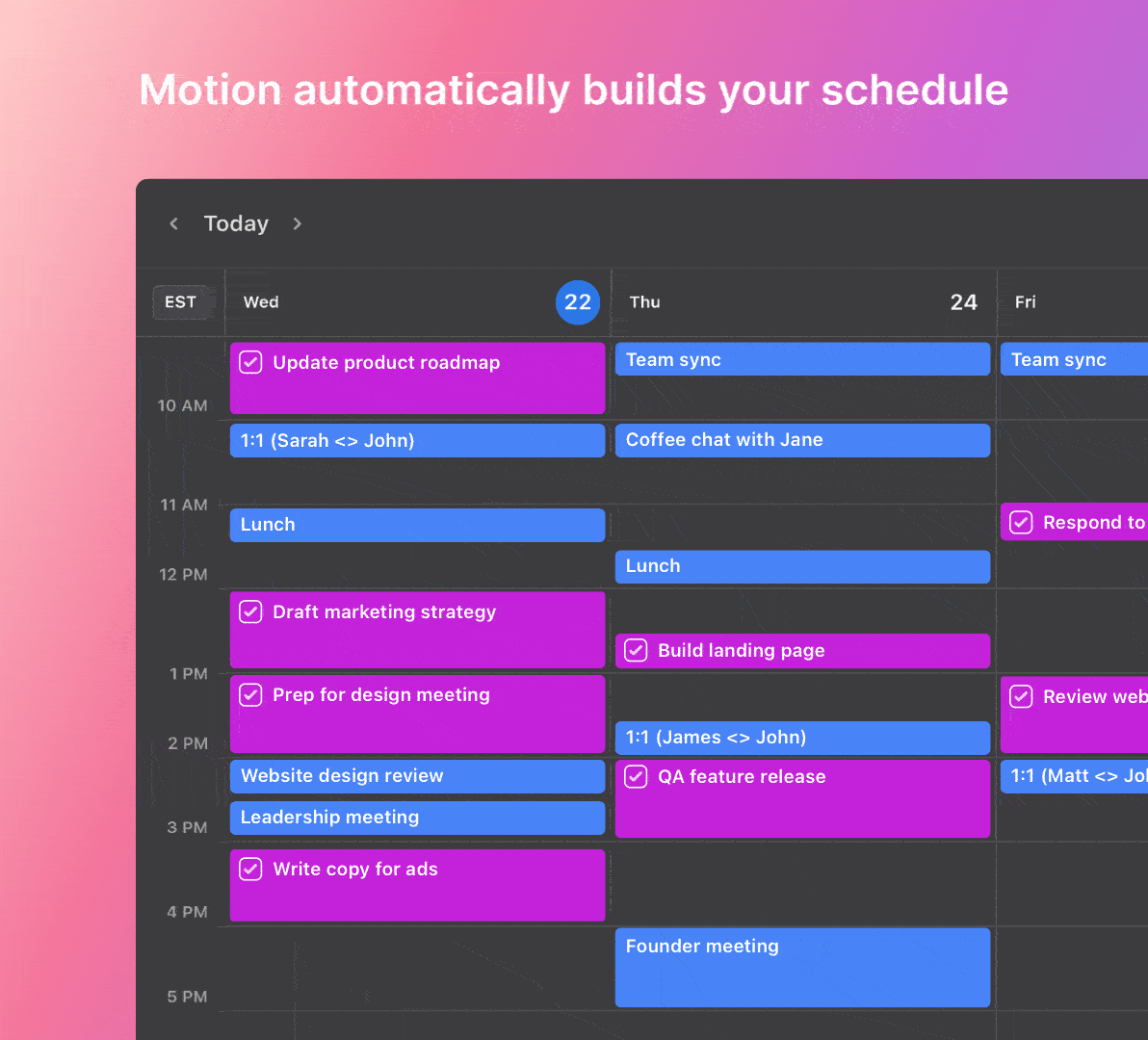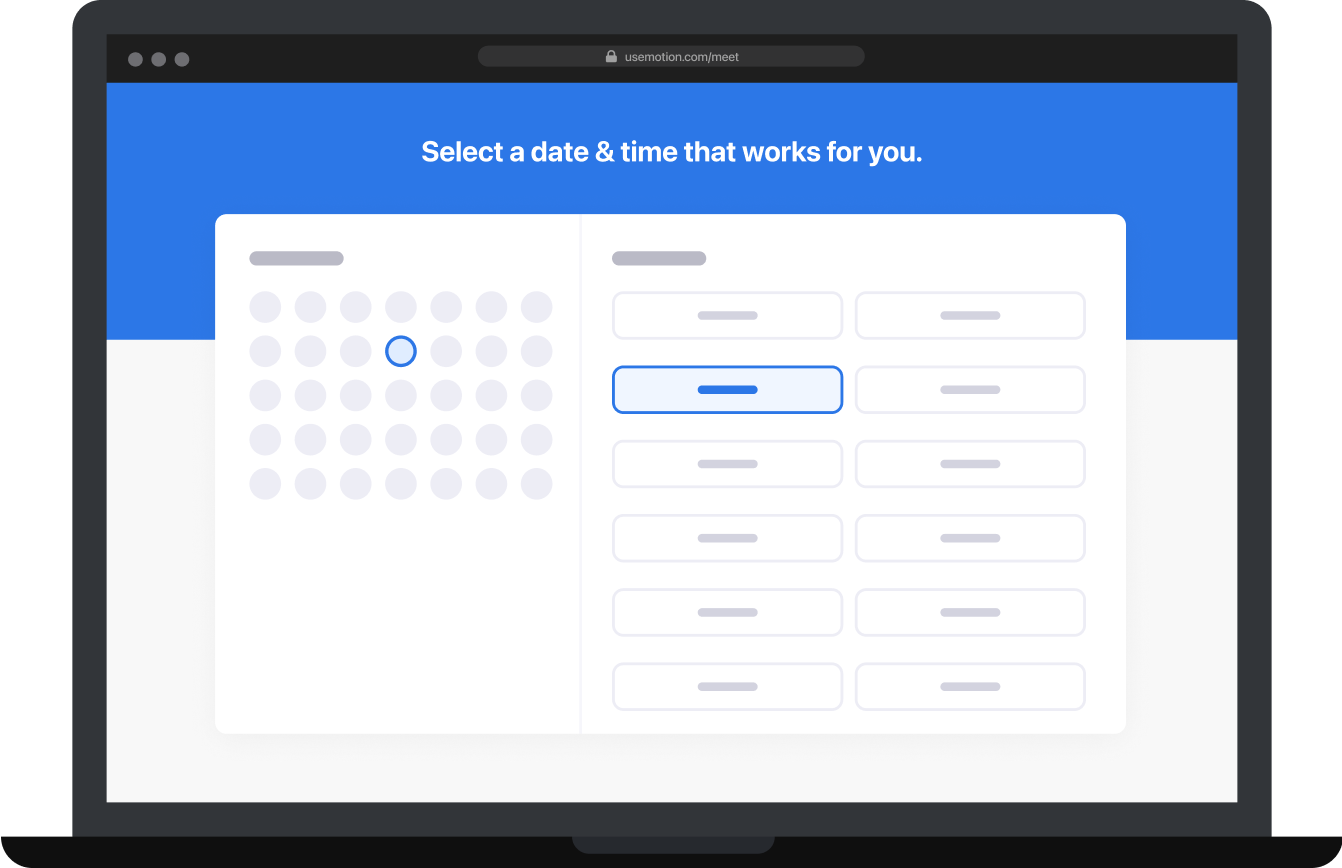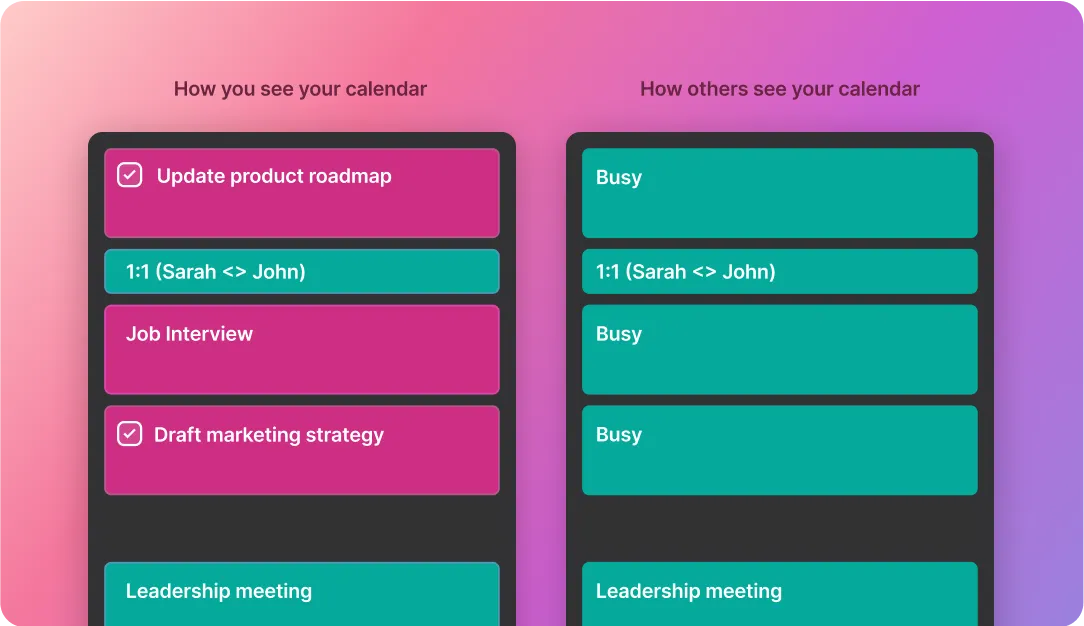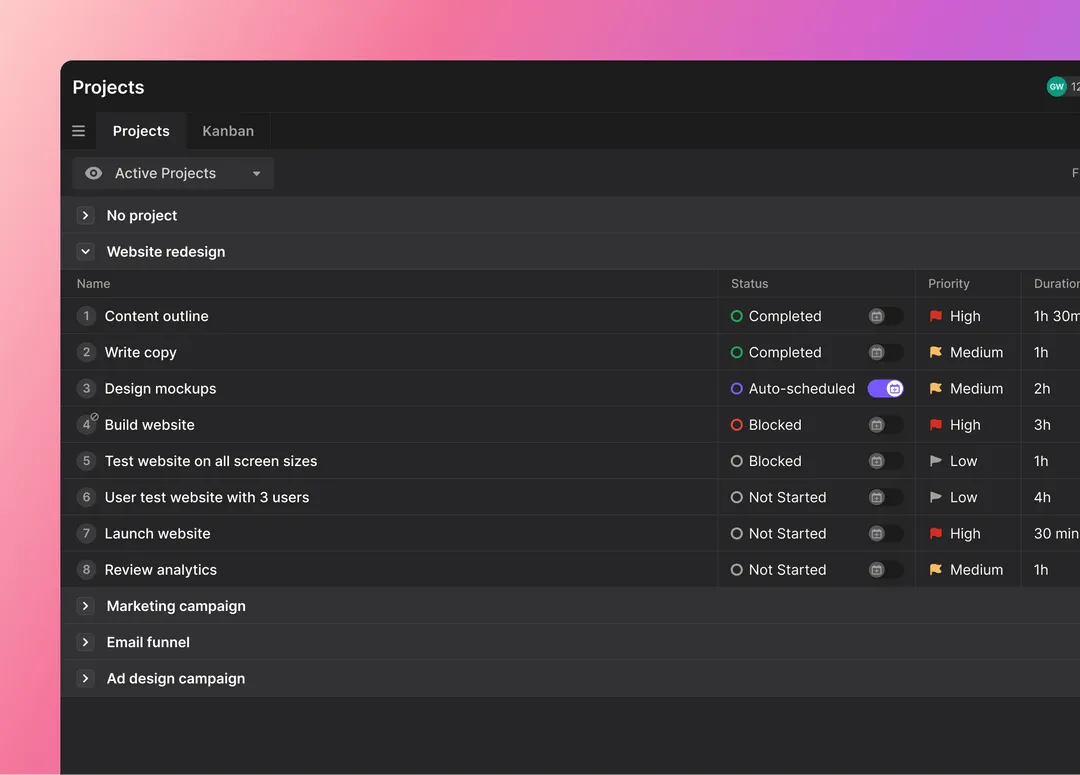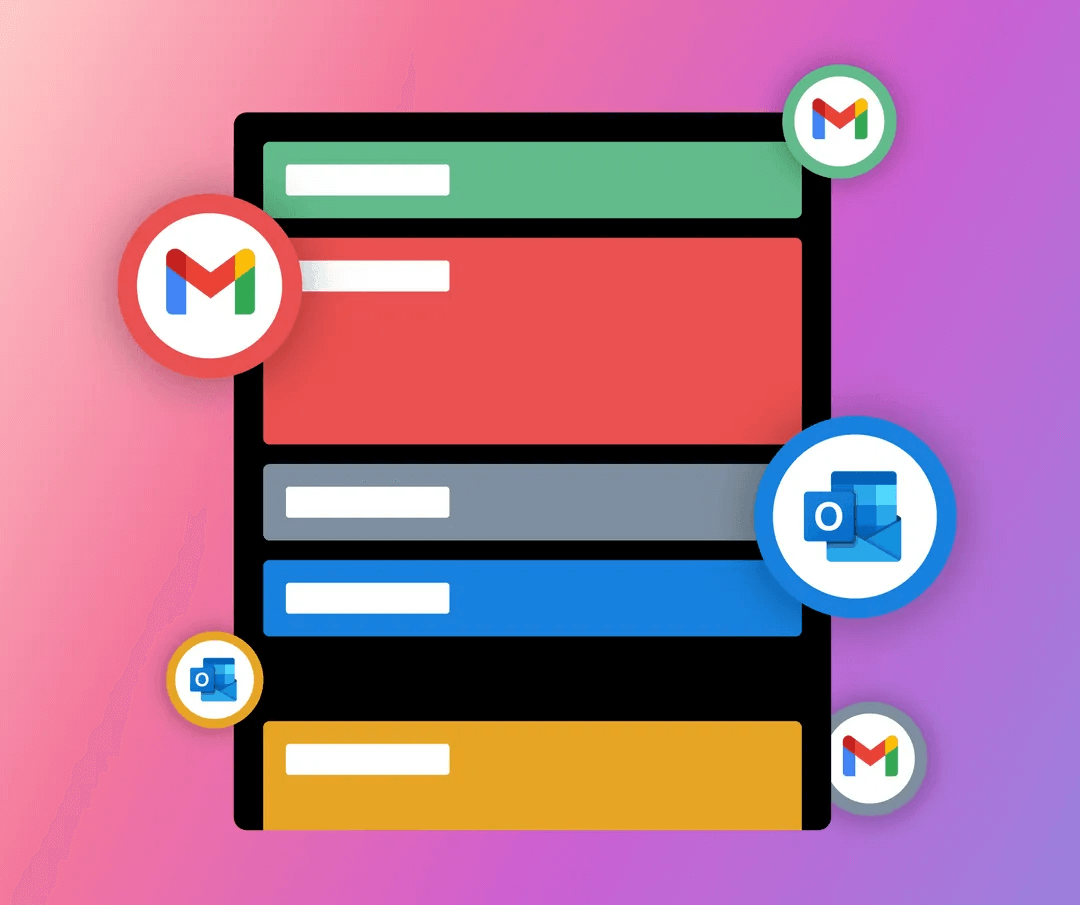There’s no room for time management mistakes in this fast-paced world. Projects need to run efficiently and effectively, on time and within budget.
Up until recently, Gantt chart software has been one of the best ways to do this. You get a clear visual of your tasks, and you can see overlaps easily.
The problem with Gantt charts is that they rely on manual scheduling. Motion goes beyond traditional Gantt charts, leveraging artificial intelligence to streamline workflows and boost productivity.
In this article, we’ll explore the pros and cons of Gantt charts and how AI scheduling eliminates the problems of manual Gantt tools.
What’s Gantt chart software?
Gantt chart software is a popular time and project management tool.
These tools help you visually map out tasks, deadlines, and milestones on a timeline, providing a clear, graphical representation of a project's roadmap.
While simple in concept, choosing the right Gantt chart software can make a world of difference. Since you’ll need to schedule the tasks yourself, you’ll have to think about chart functionality, ease of use, and customizability.
But in an age of automation and artificial intelligence (AI), is Gantt the best we can do?
Of course not. Motion's AI-powered solution reimagines how we organize, prioritize, and manage tasks, facilitating team collaboration by automatically scheduling projects in real time.
Find out more below or try Motion for free now.
What’s Gantt chart software for? Use cases in action
As a project manager, you know the intricacies of handling complex projects.
Up until now, Gantt chart software has been a go-to project management tool for managing these multifaceted tasks.
The simple chart creator helps you visualize project timelines, dependencies between tasks, and project schedules. Its easy-to-digest chart timeline is its real draw.
Whether you're a start-up agency juggling multiple client projects or a team creating various products, Gantt chart software provides a way to track project progress in real-time.
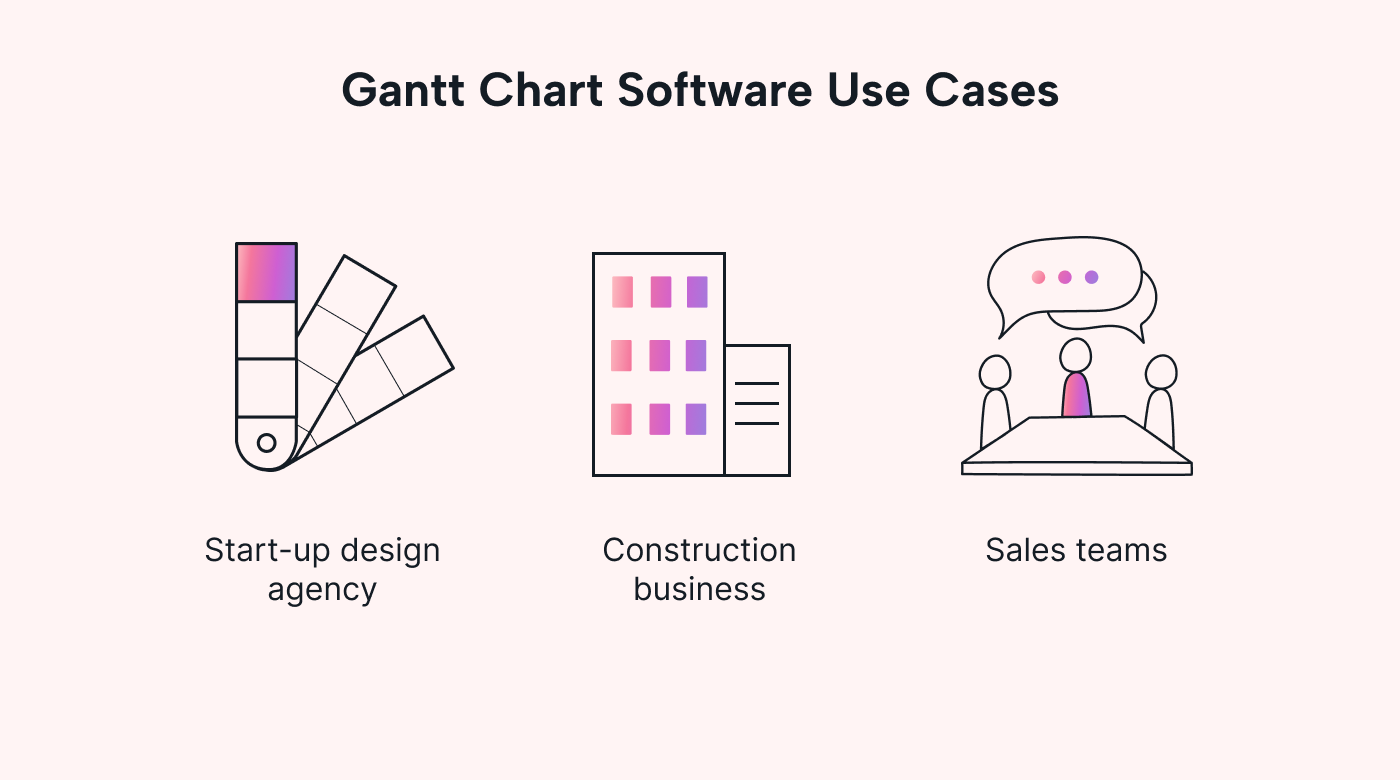 |
For instance, imagine you run a design agency. The colored bar charts help you track and manage client projects that run at the same time, clearly showing overlaps.
This helps you better organize your time to fit in all project steps and track the progress of simultaneous projects at once.
Alternatively, picture yourself running a construction firm.
Your Gantt chart platform helps you meet project deadlines by organizing your resources.
The task dependencies make it easier to schedule staff shifts, manage the flow of tools and equipment, and streamline task coordination.
Now you’re a sales manager, managing the call schedules of your sales team.
Gantt chart tools give you clear visibility of your team’s schedules and appointments, allowing you to allocate tasks based on availability.
Remember, though, despite its merits, Gantt chart software does have its limitations — it’s why so many people try Motion instead.
But first, the benefits of Gantt chart tools.
Benefits of Gantt chart software
Gantt chart software, one of the most widely used project management apps, offers tools to help manage projects on time and on target.
Here are the key benefits of the Gantt chart template for your project tasks.
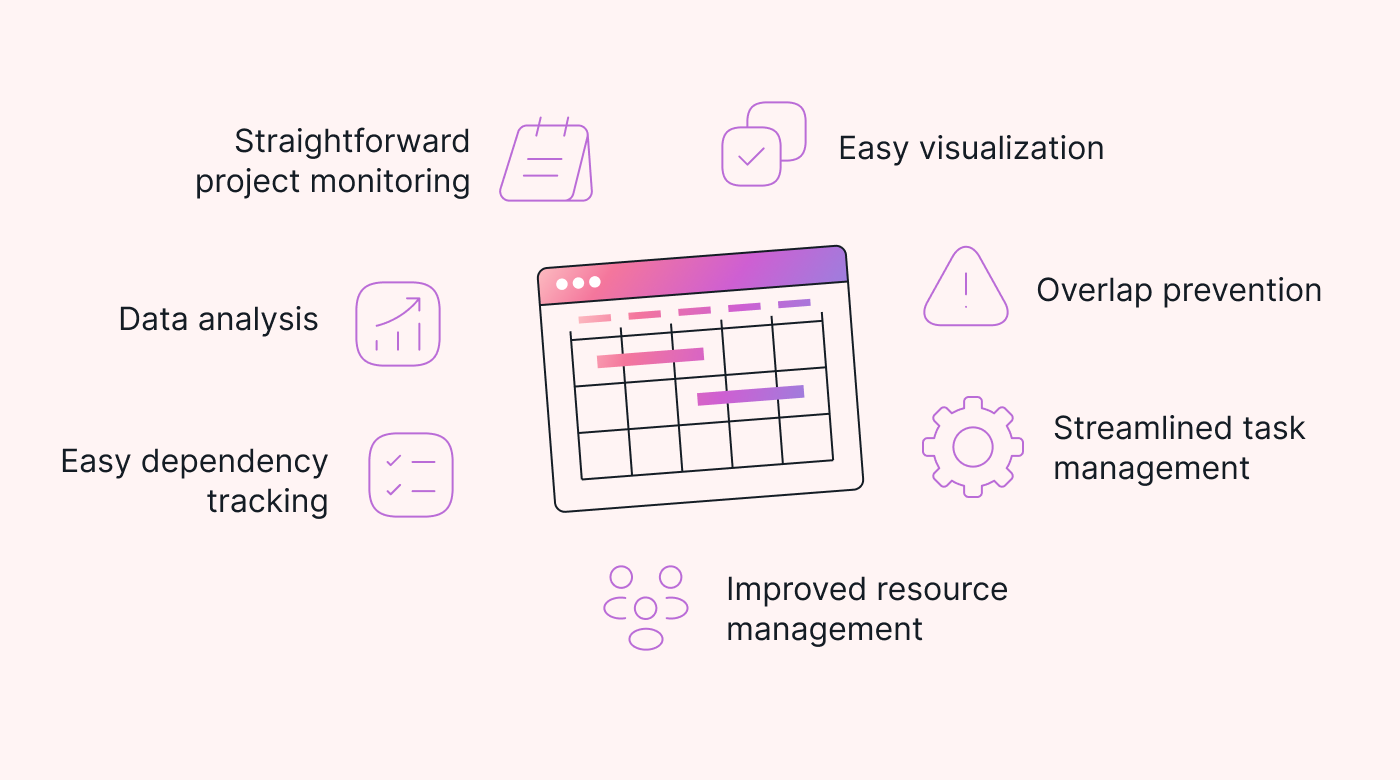 |
- Easy visualization: Gantt chart software is most famous for its clever visual representation that makes it easy to view your entire project. Its high-level view of the entire project provides a birds-eye view of the project's progress.
- Intuitive interface: Gantt chart tools tend to have an easy-to-use interface that allows you to view and manage task details, dependencies, and timelines.
- Improved task management: Divide and schedule large projects into manageable tasks, and view the chain of tasks all in one project dashboard. This is much easier than trying to view your entire team’s workload on different calendars.
- Dependency tracking: With the help of the chart diagram, Gantt tools make it simple to create and manage dependent tasks for a clear view of project tasks and their interconnections.
- Better resource management: If you’re not managing resources effectively, you’ll run out of time, money, equipment, or all of the above. Gantt chart capabilities allow you to plan and allocate resources effectively so you know when and where resources are in use.
- Project monitoring: Gantt charts provide real-time project views for you to track work time and benchmark progress against your project goals. That way, your projected timeline doesn’t run away with “scope creep” and dependency delays.
- Overlap prevention: Gantt chart calendar view makes it easy to identify overlapping tasks. You can resolve potential scheduling conflicts as they arise.
- Data analysis: Gantt chart reporting tools record project details to provide project insights for future planning and analysis. This helps you refine and improve project management strategies as you go.
While Gantt chart software gives a clear overview of your projects, you still have to waste lots of time planning and scheduling.
Below are some of the main limitations of Gantt Charts. (Spoiler Alert: Motion solves them all.)
What are the limitations of Gantt chart software?
Despite Gantt chart software's pretty good project management functions, its limitations become evident when compared to tools like Motion. It simply doesn't drive the same level of efficiency, productivity, and innovation among teams, as it lacks sophisticated automation.
This list highlights some of the main shortcomings of Gantt chart software.
- Manual schedule optimization: With Gantt charts, you have to schedule your own tasks. While you might think you know how to best manage your time, you’re probably more inefficient and error-prone than you think.
 |
Not only that, but manual scheduling is slow. The lag time in updating your actual timeline can lead to overlaps and mismanaged schedules.
- Basic planning and coordination: Yes, Gantt charts provide a great visual representation of task progress, but it’s still on the project manager to coordinate daily tasks and handle status updates manually. You can streamline this easily with automation and AI.
- Lack of agility: Gantt charts aren’t as flexible as they are visually pleasing. Quick changes or unexpected disruptions have to be handled manually. This lack of agility can cause delays and miscommunication within larger teams.
- Time-intensive setup: Creating and maintaining a detailed Gantt chart requires a lot of time and effort. You need to set each task duration, dependency, assignee, etc. You have to manage status updates, create reports, and manually interpret the data. It’s tedious and labor heavy.
- Complex for large projects: The best bit about Gantt charts is their visual clarity. But, once you have a screen full of bar charts, it gets messy. Large-scale projects that deal with numerous tasks and different types of task dependencies will likely find Gantt charts overly complex and difficult to manage.
- Basic communication features: While Gantt charts offer a platform for planning, they often lack advanced communication features like real-time messaging or file sharing. The absence of real-time collaboration features makes it hard to coordinate teams quickly.
- Poor resource efficiency: Resource allocation is also manual when you’re using Gantt chart software. You can’t really track time or resources in real time, so you can’t be sure if you’re under- or over-utilizing resources.
 |
- Limited customization: You may find you can’t get the detailed customization options you need for complex projects. This makes it tough to tailor your charts to specific project requirements or adapt to changing project landscapes.
- Limited predictive analytics: While Gantt charts can analyze and report the manual tasks you’re doing, they don’t have the advanced tools that improve scheduling through predictive analytics. Tools like Motion predict the best ways for you to prioritize time instead of simply pointing out what’s slowing you down.
Goodbye Gantt charts — Motion’s approach is the future
Solve the limited functionality of Gantt charts with a tool that redefines everything you know about scheduling.
Take 90% of project planning off your plate, streamline team scheduling, and never miss a meeting again with Motion.
Dynamic AI-driven task prioritization
Motion’s AI Task Manager completely reimagines task prioritization.
Instead of manually scheduling, delegating, and tracking tasks, Motion does it all for you.
It selects and schedules tasks based on factors like start dates, deadlines, priorities, and availability. Now nobody’s schedules clash, and everyone knows what they're working on next.
For team leaders, it means customizable visibility over your whole team’s schedules at once and hands-off task management.
Top features of Motion’s AI Task Manager:
- One-click tasks
- Recurring tasks
- Custom time windows
- Comprehensive notetaking
- Automatic reprioritization
- Full visibility and privacy features
Automated machine-learning schedule management
Whether you’re a solopreneur or an enterprise-level operations manager, Motion can handle your scheduling.
Our machine-learning algorithms build your schedule and automatically reorganize when priorities change.
This cuts out the time wasted on manual scheduling and adjustments and makes it easier to allocate your time productively.
As Eric Chen, OVO Fund Partner, puts it: “Motion’s ability to condense my schedule is almost priceless. I have more dedicated focus time, or time to go surfing.”
Top Features of Motion’s AI Scheduling:
- Hands-off scheduling
- Automatic prioritization
- Custom shared views
- Calendar synchronization
Custom meeting assistant
Don’t waste time booking meetings manually, especially if you need to be flexible.
Motion’s Meeting Assistant takes the manual work out of booking appointments, offering customizable time slots and automatic rescheduling.
Not only does this improve the efficiency of your meeting scheduling process, but it also keeps your reputation intact. Instead of apologetic cancellations and rushed meetings, you can relax knowing that your schedule is taken care of while you deal with urgent priorities.
Top Features of Motion’s Meeting Assistant:
- Features to limit meetings
- Availability viewing
- Availability booking page templates
- Drag-and-drop booking pages
- Automatic prioritization and rescheduling
Over-commitment and meeting visibility
Motion immediately identifies over-commitment and unexpected time delays.
Thanks to full meeting visibility, Motion can tell when you’re stuck in an appointment and will automatically reshuffle your schedule and rearrange meetings to compensate.
Over-commitment alerts let you know that you’ve packed too much into your schedule and you won’t have time to complete certain tasks. This prompts you to use Motion to help better distribute your workload.
Top Features of Motion’s Over-Commitment Tools:
- Over-commitment alerts
- Real-time meeting visibility
- Reprioritization
- Shared calendars
Proactive project management
Proactive project management requires that you not only have centralized project visibility but that you can also optimize project planning and time management automatically.
Motion’s Project Manager automates 90% of project planning and helps cut out repetitive manual tasks with automated scheduling workflows.
By measuring accomplishments and tracking behavioral patterns, Motion can detect better ways to schedule and manage your project, automatically compensating for delays and bottlenecks.
Top Features of Motion’s Project Manager:
- Full project visibility in one place
- Easy automations
- Customized schedules for team members
- Automatic reorganization based on real-time changes
Simple calendar integration
Motion doesn’t require you to migrate your calendar to a new tool — you simply synchronize your existing calendars, and you’re off.
Motion provides a central place for team members to manage their time and workload. That’s why we make it as straightforward as possible to integrate your existing calendars, minimizing the need for any additional tools or training.
Top Features of Motion’s Calendar Integration
- Integrates with most popular calendar tools
- Simple integration within minutes
Improved efficiency
With Motion, tasks can be completed faster and more efficiently.
Thanks to dynamic prioritization, automated scheduling, and full project visibility, you can cut out a huge chunk of repetitive tasks.
With the time you and your team save, you can focus on more important tasks that develop and enhance your business in more creative and innovative ways.
And since you don’t have to worry about calendar clashes or meetings over-running, you can turn your full attention to the important appointments at hand.
Gantt’s good, but Motion’s better
Gantt charts are a clear way to see your tasks laid out, allowing you to spot any overlaps.
Motion takes your working day and provides the most efficient schedule for you and your team. Plus, it improves over time, and, of course, there are never any overlaps.


